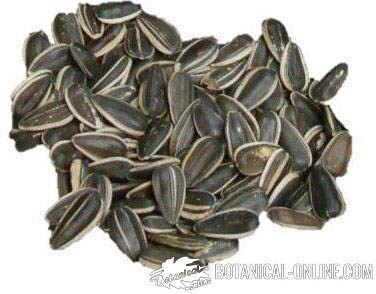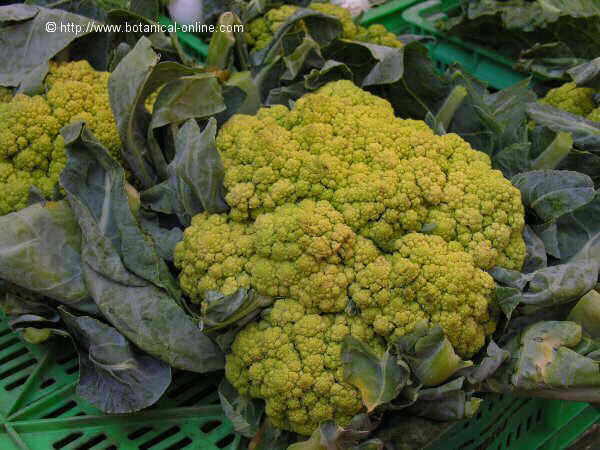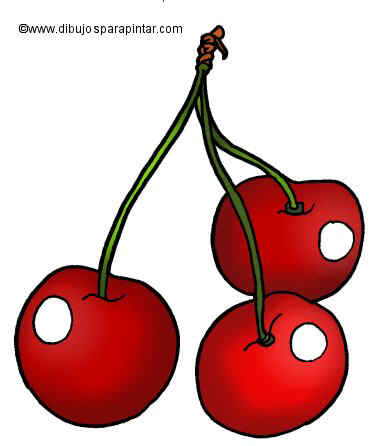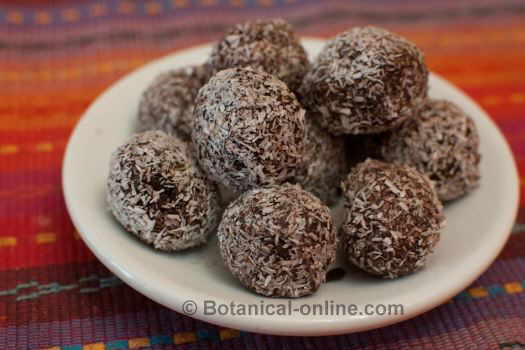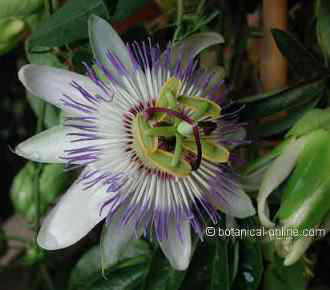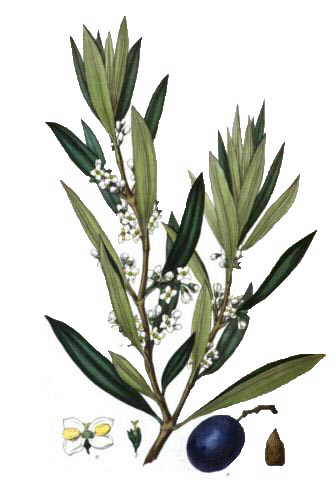Contents
- 1 How to identify and cure holm oak anomalies
- 1.1 HOLM OAK DISEASES
- 1.2 Oak branch dieback or canker of branches
- 1.3 Root rot in holm oak
- 1.4 Root rot fungus in holm oaks
- 1.5 Witch’s brooms in holm oak
- 1.6 Oak tinder fungus
- 1.7 HOLM OAK PESTS
- 1.8 Butterflies whose larvae feed on holm oak leaves and young shoots
- 1.9 Insects that lay eggs on the underside of the leaves and whose larvae feed on them.
- 1.10 Xylophagous beetles that lay their eggs inside the bark of holm oaks
- 1.11 Other insects
How to identify and cure holm oak anomalies
HOLM OAK DISEASES
The main diseases are fungal. Among them we have:
Oak branch dieback or canker of branches
It is a fungal disease caused by fungi of the genus Diplodia sp. (Diplodia quercinea, Diplodia Quercus, Diplodia mutila) and Hypoxilum (Hypoxilum mediterraneum).
Among the most characteristic symptoms of this disease we have the yellowing and subsequent browning and fall of the leaves as well as the appearance of cankers and of elongated and circular cracks in the bark of the branches, or the appearance of shoots. (More information)
Root rot in holm oak
It is caused by Phytophthora fungi (Phytophthora drechsleri, Phytophthora cinnamomi and Phytophthora cryptogea). These fungi attack the roots producing the death of the absorbent hairs, which produces the dryness of the leaves due to lack of nutrients.
This type of pest, which also affects other Quercus species such as the cork oak (Quercus suber), has a higher virulence at high temperatures and high root moisture.
The prevention of the disease involves:
- Reducing irrigation
- Offering good drainage to the trees
- Choosing varieties free of this fungus in places of trust.
- Using fertilizers with systemic fungicides (phosphonates) also helps to prevent and reduce the infection.
Root rot fungus in holm oaks
It is a fungus (Armillaria mellea)that causes the death of many shrubs and trees (mango, cherry, peach, pistachio, almond, apricot, plum, papaya, kermes oak, roses, vines, etc.)
It is one of the main parasites of many plants since the mycelium is installed in its roots causing their putrefaction.
An excess of moisture and the retention of water in the soil are the main responsible for the appearance of this disease that usually attacks the animals with less force.
The fungus continues to reproduce even if the affected tree rots or it is torn off because the mycelium extends underground. The spores can be dragged by the wind and placed in contact with other trees, so they can also infect them by penetrating their tissues.
In the case of holm oak, this disease does not usually affect the trees located in holm oaks, although it is usually more frequent in oaks planted in gardens and surrounded by grass. In this case, an abundant watering, necessary to maintain the lawn, is the cause of the development of this fungus in the roots of the oaks.
There is no treatment for this disease. The trees affected by Armillaria must be cut. The best strategy is prevention. Therefore, oaks should not be planted in places infected with this fungus.
A soil that is too watered or poorly drained may favor the appearance of the disease.
A good way to prevent oaks from becoming infected is to surround them with trees that are resistant to the disease.
The roots of these trees emit compounds that neutralize the advance of the mycelium. Among these trees we have, for example: Boxwood, ash, myrtle, Aleppo pine, or carob.
Witch’s brooms in holm oak
It is a disease caused by the fungus Thaprina Kruchii. There is an accumulation of buds that are shaped like a broom, which gives the name to this disease.
The branches affected by this disease end up drying out from the point where the multiple branches are formed until the end of them. If the tree is very infected it can dry completely.
The infection occurs when the spores dragged by the wind or by insects come into contact with some wound of the bark, such as those that occur in pruning.
The treatment of the disease involves the pruning and subsequent burning of the infected branches.
Oak tinder fungus
It is a disease caused by fungi of the genus Fomes and Stereum. It causes damage to roots and wood.
HOLM OAK PESTS
The main pests affecting holm oak are:
Butterflies whose larvae feed on holm oak leaves and young shoots
Among the main ones we have:
– Tortrix vididana: It is a lepidoptera with front wings of pale green or yellow green and gray hind wings. Both the previous ones and the later ones have a white edging. Their larvae cause much damage to oaks and other trees or shrubs such as beech, birch, oak, nettle. The larvae have a dark green color that gradually becomes clear towards the back. Its head is dark red and its front legs and abdominals are black while the legs of the abdomen are reddish dark.
The larvae feed on the leaves and build their nests by rolling them and tying them with a kind of spiderweb that they segregate. All these activities produce necrosis and death of leaves and young shoots. In the latter case the oaks can not produce acorns, since they grow annually on young shoots.
To combat this pest the trees have to be sprayed with insecticides.
– Aleimma loefingianum: It is another lepidoptera of the same family as the previous one (Tortricidae). The adult specimen presents a brown coloration as well as its larvae that also build “nests” by rolling the leaves. It eats the young leaves and buds, causing a lot of damage to the plants and prevents the formation of acorns.
– Acronicta alni: Its name comes from the alder (Alnus glutinosa), although not only it feeds on this tree but it can also do it on the holm oak and other Quercus, as well as on birches, willows, roses or poplars. It is another butterfly much larger than the previous ones since it can reach more than four centimeters, from one end of the wings to the other . Its color is brown with darker brown lines and with grayish white hind wings. The caterpillars when they are adults are very striking, presented a black coloration with yellow spots on the back. They feed on leaves and dig tunnels where they lay eggs . Its incidence on trees is not very important.
Insects that lay eggs on the underside of the leaves and whose larvae feed on them.
Among all we can mention:
– Phylloxera quercus. Its attack manifests itself in the form of yellow dots.
– Asteriodaspis ilicicola. A yellow cochineal that feeds on the sap of the leaves producing its drought and defoliation of the plant.
Xylophagous beetles that lay their eggs inside the bark of holm oaks
Their larvae dig galleries that reduce the consistency of the branches and allow the entry of other microorganisms. Among the main ones we have:
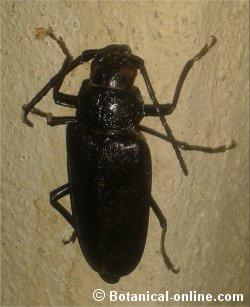
Great capricorn beetle, a flying beetle that attacks oaks
– Great capricorn beetle (Cerambyx cerdo): It is a blackish flying beetle between 2.5 and 6 cm long with long antennae that appears from May to September. The larvae, of ivory yellow color, measure up to 7 cm in length and feed on wood, digging deep galleries in the branches and trunks that can end the life of the tree. It mainly affects specimens of the Quercus genus (oaks, cork oaks, holm oaks, kermes oaks,, etc.), but they can also attack other species such as elms, ash, pear, willow, carob, etc.)
Its got a wide distribution along most of European countries, including United kingdom. It can be easily found throughout the Iberian Peninsula and North Africa ( Morocco, Argelia and Tunisia)
Although it is a species that has always existed, and fed on old and sick trees, lately its attacks on trees such as oaks and cork oaks has become more virulent producing great evils in communities such as Extremadura, the Balearic Islands, the Valencian Community and Andalusia.
The reasons for its expansion seem to be due to poor management of the forests, with uncontrolled logging or too old specimens. It is a protected insect that appears on the IUCN red list since 2006, so the use of insecticides can not be used to control this insect. In this case, a more rational handling is recommended.
– Cerambyx welensii and Cerambyx miles: They are coleoptera very similar to the Cerambyx cerdo that attack the same trees. Other xylophagous coleoptera that we can mention are: Coroebus florentinus and Agrilus grandiceps.
– Attelabus nittens: It is a brown beetle with black legs. It feeds on the leaves. The female lays the eggs in the center of the leaf and wraps it in a kind of joint formed by the folded leaf.
Other insects
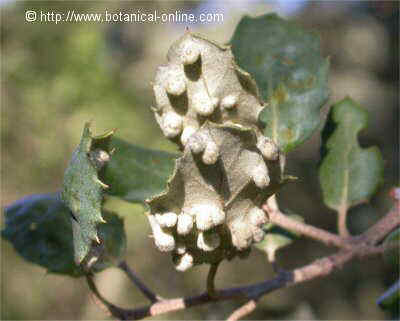
Holm oak with a leaf showing gulls in the underside
– Aceria ilicis: It is a mite that produces the “erinosis of the oak” consisting of an increase in the hairiness of the leaf, which makes the specimen useless as a garden tree.
– Plagiotrochus quercusilicis: Causes galls in the kermes oak and holm oak in a globose and elongated form that form as a small bag of reddish color that swells on both sides of the leaf, leaving it swallowed in the middle of the gill.
– Dryomyia lichtensteini: Another insect that feeds on the leaf, which determines that it produces galls on the top
![]() More information on holm oak.
More information on holm oak.

